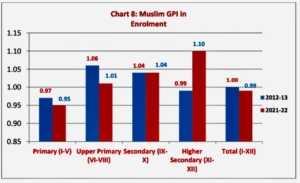Muslim Gender Parity Index at Higher Education Level in India: 2016-17 to 2020-21
The data presented in Table 33 regarding the Gender Parity Index (GPI) at the Higher Education level from 2016-17 to 2020-21 indicates positive developments for Muslim students in higher education. The fact that the GPI for Muslims has been increasing and is higher than the national average of 0.93 is a positive sign, suggesting progress toward gender equality in educational access for this community.
One significant finding from the data is the faster increase in the percentage of female Muslim students enrolling in higher education compared to their male counterparts. This trend indicates a growing interest and determination among female Muslim students to pursue higher education, showcasing the positive impact of efforts to promote gender equality and inclusivity in the education system.
The statistics for the academic year 2020-21 reveal that the percentage of Muslim girls to total enrolment at the higher education level was 50.32 percent. While this represents progress in terms of female representation, it is essential to acknowledge that there still exists a notable gender gap in the enrolment of Muslim students in higher education.
To address this disparity, a deeper examination of the data must identify the underlying factors contributing to the trends and patterns. Understanding these factors can enable the development of targeted policies and programs that empower and encourage male Muslim students to pursue higher education.
Additionally, it is crucial to recognize that the progress made in enrolling more Muslim girls in higher education may not be considered entirely satisfactory if many Muslim students do not even reach the higher secondary level. This highlights the importance of addressing educational access and quality at earlier stages, ensuring that more students can continue their education beyond the basic levels.
Policymakers and educational institutions should use this data-driven insight to create comprehensive strategies that tackle the gender gap in educational attainment among Muslim students at all levels. By providing equal opportunities and support to both male and female students from the Muslim community, India can work towards building a more equitable and inclusive higher education system, contributing to the nation’s overall development.
Table 33: Muslim GPI at Higher Education: 2016-17 to 2020-21
|
Year
|
Muslim Enrolment at Higher Education Level | ||
| GPI | % Males |
% Females |
|
| 2020-21 | 1.01 | 49.68 | 50.32 |
| 2019-20 | 1.01 | 49.81 | 50.19 |
| 2018-19 | 0.97 | 50.71 | 49.29 |
| 2017-18 | 0.96 | 51.13 | 48.87 |
| 2016-17 | 0.90 | 52.69 | 47.31 |
Source: Calculated based on AIHES 2020-21.
Muslim Gross Enrolment Ratio at School Education in India (2021-22)
State-wise Muslim Gross Enrolment Ratio at School Education in India (2021-22)
Muslims Gross Enrolment Ratio at Higher Education Level (2020-21)
Average Annual Growth Rate: Muslim Enrolment in Higher Education





